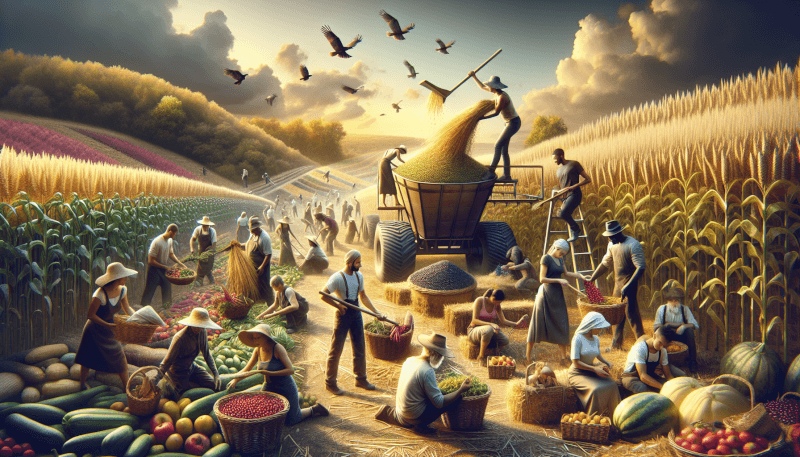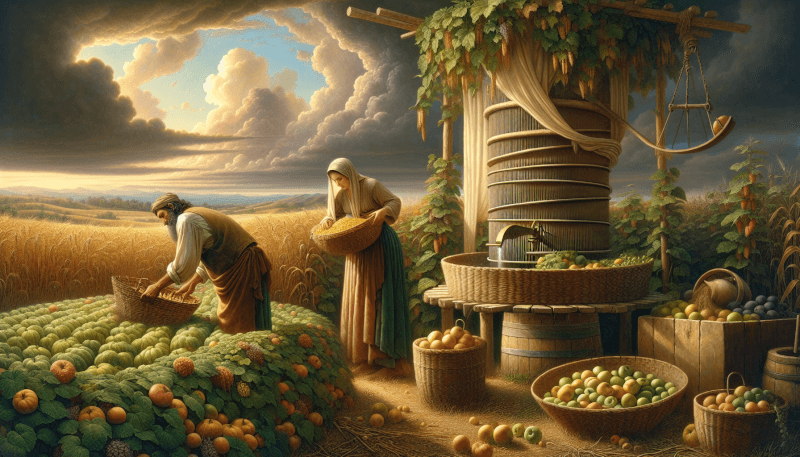Have you ever wondered about the fascinating process of harvesting? From the vast fields of golden wheat to the abundance of ripe fruits in orchards, harvesting is a crucial activity that brings us the bounties of nature. It’s a captivating journey filled with hard work, precision, and anticipation, where farmers meticulously gather the fruits of their labor to nourish communities and fill our plates with nourishment. Join us as we explore the intricacies of harvesting and uncover the magic behind this essential and rewarding practice.
Harvesting

Definition and Importance of Harvesting
Harvesting is the process of gathering mature crops or plants from the field or garden for consumption, sale, or storage. It is a crucial step in the agricultural cycle and plays a vital role in ensuring food security and economic sustainability. Harvesting at the right time is important to maximize crop yield and quality, as well as to prevent losses due to environmental factors or pests.
Types of Harvesting
There are two main types of harvesting: manual harvesting and mechanical harvesting.
Manual harvesting involves the use of hand tools and manual labor. It is often preferred for crops that require delicate handling, such as fruits and vegetables. Manual harvesting allows for careful selection and sorting of produce, ensuring optimal quality. It also provides employment opportunities for local communities, particularly in rural areas.
On the other hand, mechanical harvesting involves the use of machinery and equipment. It is commonly used for crops that can be harvested on a large scale, such as grains, oilseeds, and sugarcane. Mechanical harvesting provides efficiency and speed, reducing the labor costs and time required for harvesting. However, it may not be suitable for crops that are vulnerable to damage during the harvesting process.

Crop Harvesting Methods
Different crops require different harvesting methods to ensure optimal yield and quality.
For example, cereal crops like wheat and rice are often harvested using a combine harvester. This machine cuts, threshes, and separates the grain from the straw in a single operation. It significantly reduces the amount of labor required and ensures minimal grain loss.
Fruits and vegetables, on the other hand, are usually handpicked to avoid bruising or damaging the produce. Careful selection and handling are essential to prevent spoilage and maintain the overall quality of the harvested fruits and vegetables.
Machinery and Equipment Used in Harvesting
Mechanization has revolutionized the harvesting process, making it faster, more efficient, and less labor-intensive. Various machines and equipment are used in different stages of harvesting.
Combine harvesters, as mentioned earlier, are commonly used for cereal crops. These machines have cutting units, threshing drums, and cleaning systems that separate the grain from the straw and chaff.
For root crops like potatoes, specialized machines known as potato harvesters are used. These machines dig up the potatoes from the soil, separate them from the vines and soil, and collect them in a hopper for further processing.
Other harvesting equipment includes grape harvesters for vineyards, tobacco harvesters, cotton pickers, and forage harvesters for silage production. Each machine is designed to optimize the harvesting process for specific crops, reducing labor requirements and improving efficiency.

Harvesting Techniques for Specific Crops
Different crops require specific techniques for optimum harvesting. Here are a few examples:
Wheat: Wheat is harvested when the crop reaches full maturity, and the moisture content is low. The combine harvester cuts the crop close to the ground, separates the grain, and deposits it into a container. The straw is left on the field for later use as animal feed or bedding.
Apples: Apples are typically handpicked to avoid damage to the delicate fruit. Harvesters climb ladders or use platforms to reach the highest branches, carefully selecting ripe apples and placing them in bins or crates.
Tomatoes: Tomatoes are generally harvested when they are fully ripe but not overripe. Hand harvesting involves carefully cutting the mature fruit from the vine, taking care not to bruise or damage it. Mechanical harvesting techniques, such as shake and catch or conveyor systems, are also used for large-scale tomato production.
Post-Harvest Handling
Post-harvest handling refers to the processes that take place after harvesting to ensure the quality and preservation of the harvested crops. It includes activities such as cleaning, sorting, grading, storage, and packaging.
Cleaning involves removing any dirt, debris, or foreign material from the harvested produce. Sorting and grading are done based on factors like size, color, and quality to ensure consistency and marketability.
Storage is crucial to maintain the freshness and longevity of the harvested crops. Different crops require specific storage conditions, such as temperature and humidity control, ventilation, and protection from pests and diseases.
Packaging plays a vital role in protecting the produce during transportation and handling. It should provide adequate ventilation, cushioning, and protection against physical damage.

Harvesting and Sustainability
Harvesting practices can significantly impact the environment and sustainability of agricultural systems. Sustainable harvesting involves minimizing waste, reducing energy consumption, and preserving natural resources.
Optimizing the timing of harvesting is crucial to reduce losses and optimize resource utilization. By harvesting at the right time, farmers can minimize crop spoilage and ensure maximum yield, reducing the need for additional resources.
Efficient post-harvest handling and storage techniques are essential for reducing post-harvest losses, which account for a significant portion of food waste globally. By investing in proper storage facilities and optimal packaging, the shelf life and quality of harvested crops can be extended, reducing food waste and improving overall sustainability.
Promoting biodiversity and ecosystem health is another aspect of sustainable harvesting. Preserving natural habitats, adopting agroforestry or mixed-cropping systems, and avoiding environmentally damaging practices such as intensive use of chemicals or land clearing can help maintain ecological balance and promote long-term sustainability.
Challenges in Harvesting
Despite advancements in technology and techniques, several challenges persist in the harvesting process.
Labor shortage: Many regions face a shortage of skilled labor for manual harvesting. This can lead to delays in harvesting, increased labor costs, and lower crop quality.
Weather conditions: Unfavorable weather conditions, such as heavy rain or drought, can affect harvesting operations. Wet crops are challenging to harvest and prone to damage, while drought conditions may result in lower yields and poor crop quality.
Crop variability: Different crops have varying growth rates and maturation periods, making it challenging to synchronize harvesting activities. Harvesting multiple crops simultaneously can strain farm resources and create logistical challenges.

Future Trends in Harvesting
The future of harvesting is driven by technological advancements and sustainable practices. Here are some emerging trends:
Precision agriculture: The use of advanced technologies such as sensors, drones, and GPS allows farmers to monitor crop growth, identify optimal harvesting times, and minimize crop damage. Precision agriculture helps optimize resource allocation and improve overall harvest efficiency.
Robotics and automation: The development of robotic systems and automated machinery is revolutionizing the harvesting process. Robots equipped with computer vision and machine learning algorithms can accurately identify and pick ripe produce, reducing labor costs and improving efficiency.
Sustainable practices: As environmental concerns grow, there is a greater focus on sustainable harvesting practices. This includes the adoption of organic farming methods, renewable energy usage, and water conservation techniques to ensure the long-term viability of agricultural systems.
Conclusion
Harvesting is a critical stage in the agricultural cycle, ensuring the availability of food and contributing to economic sustainability. From manual labor to advanced machinery, harvesting techniques have evolved over time to improve efficiency and reduce costs. Strategies such as precision agriculture and sustainable practices are shaping the future of harvesting, focusing on minimizing waste and preserving natural resources. By understanding the importance and challenges associated with harvesting, farmers can make informed decisions and contribute to a more sustainable and productive agricultural industry.


